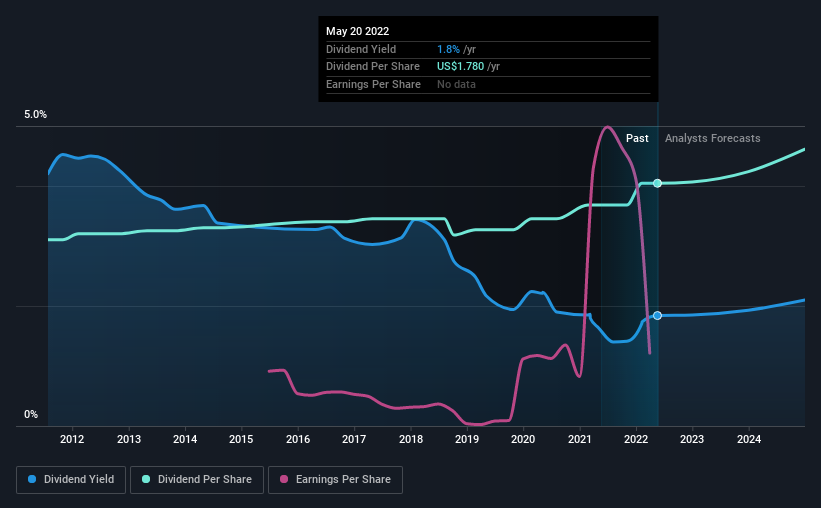Here's What We Like About Thomson Reuters' (TSE:TRI) Upcoming Dividend
Thomson Reuters Corporation (TSE:TRI) is about to trade ex-dividend in the next 3 days. Typically, the ex-dividend date is one business day before the record date which is the date on which a company determines the shareholders eligible to receive a dividend. The ex-dividend date is important as the process of settlement involves two full business days. So if you miss that date, you would not show up on the company's books on the record date. In other words, investors can purchase Thomson Reuters' shares before the 25th of May in order to be eligible for the dividend, which will be paid on the 15th of June.
The company's next dividend payment will be US$0.45 per share. Last year, in total, the company distributed US$1.78 to shareholders. Based on the last year's worth of payments, Thomson Reuters has a trailing yield of 1.8% on the current stock price of CA$124.15. If you buy this business for its dividend, you should have an idea of whether Thomson Reuters's dividend is reliable and sustainable. We need to see whether the dividend is covered by earnings and if it's growing.
See our latest analysis for Thomson Reuters
Dividends are typically paid from company earnings. If a company pays more in dividends than it earned in profit, then the dividend could be unsustainable. Thomson Reuters paid out a comfortable 49% of its profit last year. That said, even highly profitable companies sometimes might not generate enough cash to pay the dividend, which is why we should always check if the dividend is covered by cash flow. Over the last year it paid out 70% of its free cash flow as dividends, within the usual range for most companies.
It's positive to see that Thomson Reuters's dividend is covered by both profits and cash flow, since this is generally a sign that the dividend is sustainable, and a lower payout ratio usually suggests a greater margin of safety before the dividend gets cut.
Click here to see the company's payout ratio, plus analyst estimates of its future dividends.
Have Earnings And Dividends Been Growing?
Stocks in companies that generate sustainable earnings growth often make the best dividend prospects, as it is easier to lift the dividend when earnings are rising. If earnings fall far enough, the company could be forced to cut its dividend. Fortunately for readers, Thomson Reuters's earnings per share have been growing at 18% a year for the past five years. Thomson Reuters has an average payout ratio which suggests a balance between growing earnings and rewarding shareholders. This is a reasonable combination that could hint at some further dividend increases in the future.
Many investors will assess a company's dividend performance by evaluating how much the dividend payments have changed over time. In the past 10 years, Thomson Reuters has increased its dividend at approximately 2.7% a year on average. Earnings per share have been growing much quicker than dividends, potentially because Thomson Reuters is keeping back more of its profits to grow the business.
The Bottom Line
From a dividend perspective, should investors buy or avoid Thomson Reuters? From a dividend perspective, we're encouraged to see that earnings per share have been growing, the company is paying out less than half of its earnings, and a bit over half its free cash flow. It's a promising combination that should mark this company worthy of closer attention.
So while Thomson Reuters looks good from a dividend perspective, it's always worthwhile being up to date with the risks involved in this stock. To help with this, we've discovered 2 warning signs for Thomson Reuters that you should be aware of before investing in their shares.
Generally, we wouldn't recommend just buying the first dividend stock you see. Here's a curated list of interesting stocks that are strong dividend payers.
Have feedback on this article? Concerned about the content? Get in touch with us directly. Alternatively, email editorial-team (at) simplywallst.com.
This article by Simply Wall St is general in nature. We provide commentary based on historical data and analyst forecasts only using an unbiased methodology and our articles are not intended to be financial advice. It does not constitute a recommendation to buy or sell any stock, and does not take account of your objectives, or your financial situation. We aim to bring you long-term focused analysis driven by fundamental data. Note that our analysis may not factor in the latest price-sensitive company announcements or qualitative material. Simply Wall St has no position in any stocks mentioned.

